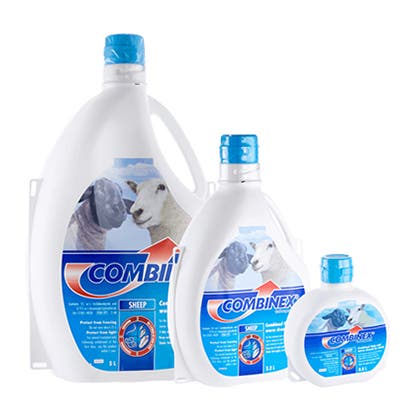Combinex™ Oral Suspension

Combinex™ Oral Suspension
Combinex Oral Suspension is a combination wormer and flukicide for sheep. Containing the group 2 (yellow) wormer levamisole hydrochloride and triclabendazole, it treats and controls parasitic gastro-enteritis and parasitic bronchitis, as well as all three stages of liver fluke disease.
Key Features
- 3 stage fluke and worm control in one dose
- Kills liver fluke down to 2 days of age
- Can be used in young or pregnant sheep
Packs available
Combinex Sheep is available in the following bottle sizes: 0.8L ; 2.2L ; 5L
Legal category: POM-VPS
Product Information
Target activity
Combinex Oral Suspension delivers wide endoparasite treatment and control in sheep against:
Gastrointestinal roundworms (adults and developing immature stage)
- Haemonchus spp
- Ostertagia spp
- Trichostrongylus spp
- Cooperia spp
- Nematodirus spp
- Bunostomum spp
- Chabertia spp
- Oesophagostomum spp
Lungworms (adults and fourth stage larvae): Dictyocaulus spp
Liver fluke: Fasciola hepatica – from 2 day old early immature to adult fluke
Special precautions for use
i. Special precautions for use in animals
- Assess bodyweight as accurately as possible before calculating the dosage.
- Animals must not be treated within a period of 14 days before or after treatment with organophosphorus compounds.
- Clean drenching equipment before and after use.
- Intensive use or misuse of anthelmintics can give rise to resistance.
- To reduce this risk, dosing programmes should be discussed with your Veterinary Adviser.
Care should be taken to avoid the following practices because they increase the risk of development of resistance and could ultimately result in ineffective therapy:
- Too frequent and repeated use of anthelmintics from the same class, over an extended period of time.
- Underdosing, which may be due to underestimation of body weight, misadministration of the product, or lack of calibration of the dosing device (if any).
Suspected clinical cases of resistance to anthelmintics should be further investigated using appropriate tests (e.g. Faecal Egg Count Reduction Test).
Where the results of the test(s) strongly suggest resistance to a particular anthelmintic, an anthelmintic belonging to another pharmacological class and having a different mode of action should be used. Resistance to levamisole has been reported in Teladorsagia, Cooperia and Trichostrongylus species in sheep in a number of countries, including ones in the EU. There are reports of resistance in Haemonchus in sheep outside the EU. Resistance to triclabendazole has been reported in Fasciola species in small ruminants in a number of countries including ones in the EU. Therefore the use of this product should be based on local (regional, farm) epidemiological information about susceptibility of nematodes and trematodes and recommendations on how to limit further selection for resistance to anthelmintics.
ii. Special precautions to be taken by the person administering the veterinary medicinal product to animals
- When using, do not eat, drink or smoke.
- Wash splashes from eyes and skin immediately.
- Take off immediately any contaminated clothing.
- Wash hands and exposed skin before meals and after work.
- Levamisole can cause idiosyncratic reactions and serious blood disorders in a very small number of people. If symptoms such as dizziness, nausea, vomiting or abdominal discomfort are experienced when using the product, or sore mouth/throat or fever occurs shortly afterwards, then medical advice should be sought immediately.
